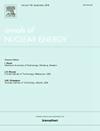Analysis of a new on-site semi-passive design to improve the safety of Generation II/II+ Pressurized water reactors
IF 1.9
3区 工程技术
Q1 NUCLEAR SCIENCE & TECHNOLOGY
引用次数: 0
Abstract
Generation II/II+ (Gen II/II+) Pressurized Water Reactors (PWRs) still account for a significant proportion of nuclear reactors worldwide. However, some Gen II/II+ PWR plants face a significant safety risk, as current accident management typically covers Station BlackOut (SBO) or Total Loss of FeedWater (TLFW) accidents individually. It is challenging to address the combination of SBO and TLFW (TMLB’), which can occur under extreme circumstances. Numerical simulations of severe accidents have indicated that this combination can lead to reactor core melting in as little as 2.5 h after the accident. To enhance the safety of Gen II/II+ PWRs during TMLB’, a new strategy called semi-passive cyclic cooling was proposed. This approach aims to delay accident progression by fully utilizing on-site resources, such as the cooling water inside the deaerator, the high-pressure steam in the Steam Generators (SG) as the driving force, and the feedwater pipeline in the secondary loop. This paper presents an uncertainty and sensitivity analysis of the semi-passive cyclic cooling performance during TMLB’. The fundamental characteristics of the semi-passive cyclic cooling strategy were studied using a best-estimate thermal–hydraulic model for the CPR1000, an improved Chinese Gen II/II+ PWR. An uncertainty analysis was then performed to assess the impact of various operating parameters of the reactor system and the semi-passive cyclic cooling system on the safety benefit, specifically in terms of delayed reactor core uncovery. Sobol sequence sampling-based simulations demonstrated that the semi-passive cyclic cooling system can significantly delay reactor core uncovery, with delays of 9.3173 to 9.606 h for the 5th percentile value, depending on the mode of deaerator pressurization (1,000 samples for each mode). Finally, a sensitivity analysis with both local and global methods indicated that the initial water level in the deaerator is the most critical parameter affecting the time to reactor core uncovery.
求助全文
约1分钟内获得全文
求助全文
来源期刊

Annals of Nuclear Energy
工程技术-核科学技术
CiteScore
4.30
自引率
21.10%
发文量
632
审稿时长
7.3 months
期刊介绍:
Annals of Nuclear Energy provides an international medium for the communication of original research, ideas and developments in all areas of the field of nuclear energy science and technology. Its scope embraces nuclear fuel reserves, fuel cycles and cost, materials, processing, system and component technology (fission only), design and optimization, direct conversion of nuclear energy sources, environmental control, reactor physics, heat transfer and fluid dynamics, structural analysis, fuel management, future developments, nuclear fuel and safety, nuclear aerosol, neutron physics, computer technology (both software and hardware), risk assessment, radioactive waste disposal and reactor thermal hydraulics. Papers submitted to Annals need to demonstrate a clear link to nuclear power generation/nuclear engineering. Papers which deal with pure nuclear physics, pure health physics, imaging, or attenuation and shielding properties of concretes and various geological materials are not within the scope of the journal. Also, papers that deal with policy or economics are not within the scope of the journal.
 求助内容:
求助内容: 应助结果提醒方式:
应助结果提醒方式:


